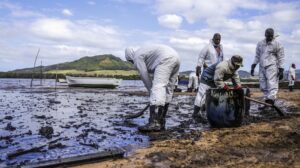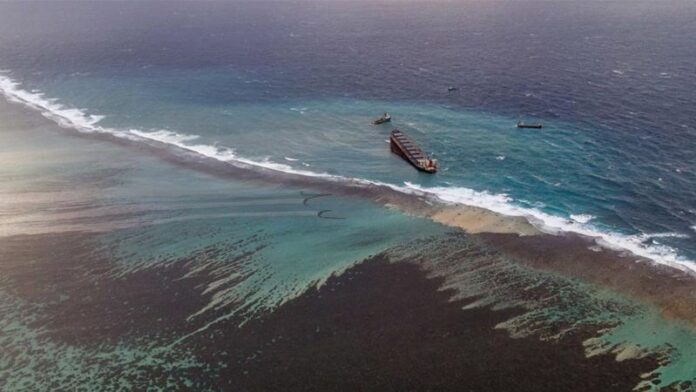Mauritius’ Prime Minister, Pravind Jugnauth gas expressed fear over the possibility of a ship that is leaking tonnes of oil into the ocean cracking and threatening an even greater ecological and economic disaster for the island nation.
More than 1,000 tonnes of fuel have seeped from the bulk carrier MV Wakashio into the azure sea off southeast Mauritius, befouling the coral reefs, white-sand beaches and pristine lagoons that lure tourists from around the globe.
However, another 2,500 tonnes remain aboard the stricken vessel which ran aground on a reef on July 25. It only started oozing from a crack in the hull in the past week.
Experts warn a further rupture could unleash a spill that would be beyond catastrophic for the fragile coastal ecosystem upon which Mauritius and its economy relies.

Prime Minister Pravind Jugnauth, on Sunday, said response crews had managed to stymie the leak for now but were bracing for the worst.
“The cracks have grown. The situation is even worse,” he said, adding, “The risk of the boat breaking in half still exists.”
Japan, on Sunday, said it would send a six-member expert team to assist with what Mauritius had declared an unprecedented environmental emergency.
France also dispatched a naval vessel, a military aircraft and technical advisers from nearby Reunion Island after Mauritius appealed for international help.
Thousands of volunteers, many smeared head-to-toe in black sludge, have marshalled along the coastline, stringing together miles of improvised floating barriers made of straw in a desperate attempt to hold back the oily tide.
Mitsui OSK Lines, which operates the vessel owned by another Japanese company, promised on Sunday to “make all-out efforts to resolve the case.
“We are terribly sorry,” the shipping firm’s Vice President, Akihiko Ono told reporters in Tokyo.
But some fear the damage is already done.
Aerial images show the enormity of the disaster, with huge stretches of crystal-clear seas around the marooned cargo ship stained a deep inky black.
Thick muck has coated mangrove forests and unspoiled inlets up and down the coastline, exacting irreparable harm and undoing years of painstaking conservation work, environmental activists say.
The slick has already begun drifting further up the coast, fanned along by strong winds and currents.
“I think it’s already too late. If the ship breaks in two, the situation will be out of control,” Vassen Kauppaymuthoo, an oceanographer and environmental engineer, told AFP news agency.
“We’re talking about a major disaster that is progressing and it’s getting more complicated hour by hour.”
Source:www.energynewsafrica.com















